- This topic has 51 replies, 6 voices, and was last updated 8 years, 10 months ago by
 Bill Ward.
Bill Ward.
-
AuthorPosts
-
18 December 2014 at 8:20 pm #573399
 Bill WardParticipant
Bill WardParticipantHi All,
With the general idea six years in the making I’ve finally been able to, sort off 😉 , start to produce a meteor spectrum “family chart” like you see for stellar classifications.
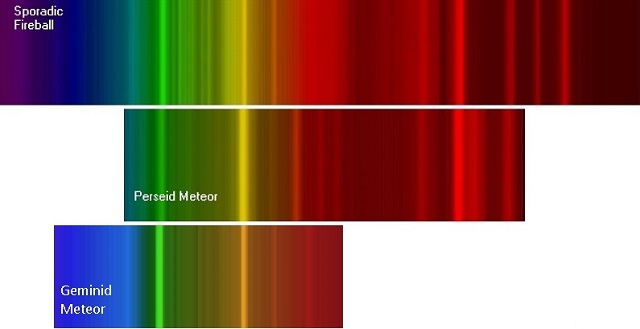
It is utterly fascinating to see how they are all similar but different! The sporadic fireball has many iron lines in the blue and green whilst the Perseid has quite a strong Hydrogen line and several Silicon lines in the red and near IR.
The Geminid has very strong magnesium emissions.
Brill!
Cheers,
Bill.
Attachments:
19 December 2014 at 7:31 am #576714 William StewartParticipant
William StewartParticipantHi Bill,
Excellent – really pleased to see you obtaining this quality of data. Obviously the different spectra are of different widths … is this a reult of the use of different gratings for the different observations?
Best regards
William
19 December 2014 at 9:50 am #576715 Bill WardParticipant
Bill WardParticipantHi William,
The size, that is span of wavelength, is just a consequence of what bit of the spectrum was in the field of view.
The actual dispersion is the same. The sporadic fireball was a bullseye. It went across the fov slightly diagonally but dead centre. So the whole range of the (silicon) detector was utilised and a full range spectrum was caught, from the UV cut off of the glass to nearly the edge of the silicon “band gap” at just over 1000nm. Actually that was a remarkably lucky catch!
You have a greater chance of catching the whole spectrum if one uses a lower dispersion grating. But then the resolution drops, it’s all a compromise.
cheers,
Bill.
19 December 2014 at 5:16 pm #576716 Jeremy ShearsParticipant
Jeremy ShearsParticipantGreat work, Bill. Fascinating to see the results you are obtaining. Hopefully we’ll soon get some multi-station captures of the same event, to tie in with your spectroscopy.
Go well!
Jeremy23 December 2014 at 1:39 am #576720 Bill WardParticipant
Bill WardParticipantHi,
Been working through some more spectra. This one looks really nice in the blue. Mostly Iron (Fe) lines here with some additional weak Magnesium lines in the near UV. Taken on 2014 11 15 : 051157UT but using a 300 groove/mm grating. However this shows the effect of “good” geometry even at relatively low dispertions. Looks like a stony iron sporadic.

Cheers,
Bill.
23 December 2014 at 8:00 pm #576721 Bill WardParticipant
Bill WardParticipantNow for a plain old iron meteor….
With the exception of a couple of magnesium lines these are all probably iron lines.

Meteor 2014 04 19 : 235419UT
The family tree is growing….
3 January 2015 at 10:04 pm #576736 Bill WardParticipant
Bill WardParticipant….and growing….
Another nice fireball spectrum.This is getting towards the highest resolution meteor spectrum taken using the WATEC generation of video cameras.
A 600 groove/mm fused silica grating but the meteor was caught in the second order so roughly equivalent of a 1200 groove/mm grating in the first order. The double line at the sodium wavelength is genuine. It can be seen evolving in the video but I haven’t been able to identify what it is (yet) The system resolution, even in the second order, doesn’t have the ability to split the sodium doublet so it’s not that. Another interesting meteor mystery!

Fireball 2014 12 28 : 0450UT
Cheers,
Bill.
18 March 2015 at 8:43 pm #576802 Bill WardParticipant
Bill WardParticipantHi,
I think this is quite an interesting little spectrum. 0508UT 15/3/15. Not very bright and very few lines visble. However it has exceptionally bright OI emission from the “forbidden” transision at 557.7nm. Looking at any other of my spectra here there is no comparable emission in any of them!

Due to the quantum mechanics involved this is a meta stable state, the O atoms sit excited for 0.74 seconds before emitting the photon. So it only occurs with meteors that are very swift and start to or completely abalate above ~100-110km. Below this the atmosphere quenches the transition through collisional loss.
The usual strong Mg and Na so looks like a stony job but it must have been coming straight at us for a very fast effective impact speed. A fascinating addition to the diagnostic info available.
cheers,
Bill.
10 April 2015 at 8:56 pm #576839 Bill WardParticipant
Bill WardParticipantHi,
A first (as far as I know) for UK meteor observing early this morning. Working with some of the Nemetode group I finally caught a meteor that was also captured with the Nemetode observers’ camera (David, just outside Girvan). This is a great step forward as it means we can now have orbital AND compositional information for meteors.
Here is my capture frame:
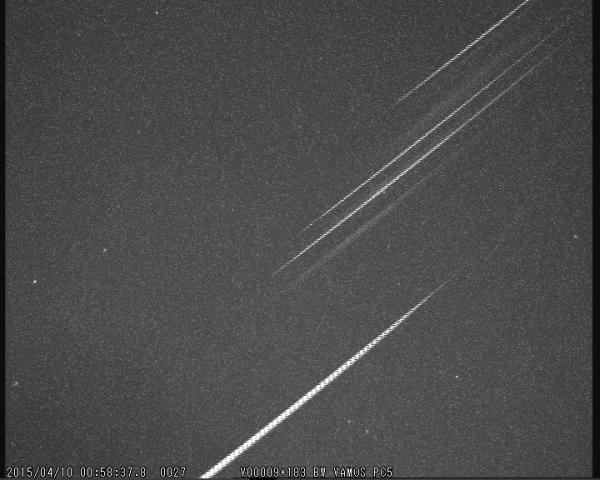
And here is Davids image:
Doing the usual spectrum processing reveals very strong Magnesium and Sodium emmisions but there are also bands of iron in the spectrum. So it looks like this was a stony iron meteor, thus:
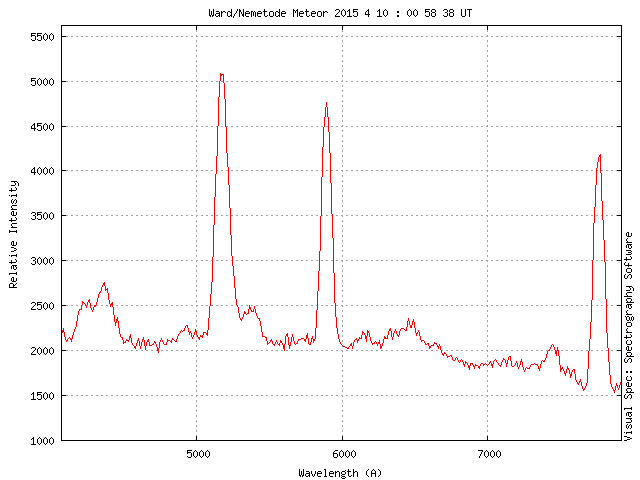
and the usual colour treatment:

There is the possibilty that it was caught from another location which would give a much better orbital fit. Hopefully Dennis will have re positioned his camera.
It’s all good stuff :-))
cheers.
Bill.
11 April 2015 at 8:22 pm #576840 Bill WardParticipant
Bill WardParticipantHi,
After a bit of messing around I managed to produce this sky track for the meteor in UFO Analyser. William will be doing the orbital analysis of myself and Dave’s data (as well as hopefully Dennis’s)
It seems that this might well be a Lyrid. However once the orbit has been determined we should have a better idea of the certainty of that.
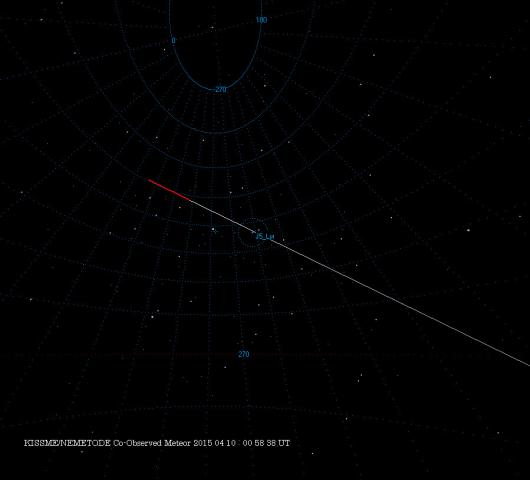
(To his credit he came up with the highly imaginative name/acronym for my spectroscopy programme. Much better than what I had originally thought :-)))
Looking good.
Cheers,
Bill.
11 April 2015 at 10:05 pm #576841 Bill WardParticipant
Bill WardParticipantAfter some quick work by William, the orbit indicates a low inclination sporadic.
Bill.
19 April 2015 at 11:32 pm #576849 Bill WardParticipant
Bill WardParticipantHi,
Another interesting spectrum to consider. I caught an usual spectrum on the morning of the 13th. Unusually it only had one bright line in the green. I initially assumed this would be magnesium. WRONG! The alarm was raised when the atmospheric lines (to the right hand side of the spectra) didn’t fit. After trying a few lines from the NIST reference library the best candidate was from iron. Re calibrating using the atmospheric oxygen line, the green line did seem to fit with an iron emission. So did the blue iron and calcium lines. So I’m confident this is a reasonable fit.
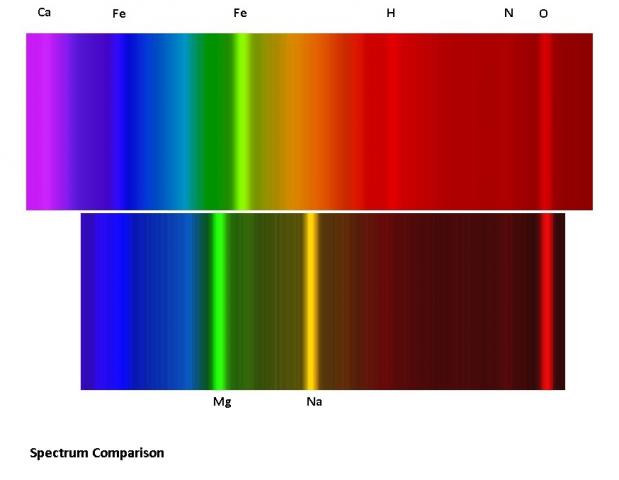
I’ve compared it to the spectro-orbital capture from the 4th to show the differences. The one from the 4th looks like a stony/stony iron with the rich Fe, Mg and Na lines. What this one is I don’t know.
Yet another one for the zoo….
cheers,
Bill.
23 April 2015 at 9:49 pm #576850 Bill WardParticipant
Bill WardParticipant….And another….
A really well dispersed spectrum of a sporadic meteor captured on the night of the Lyrid shower peak.
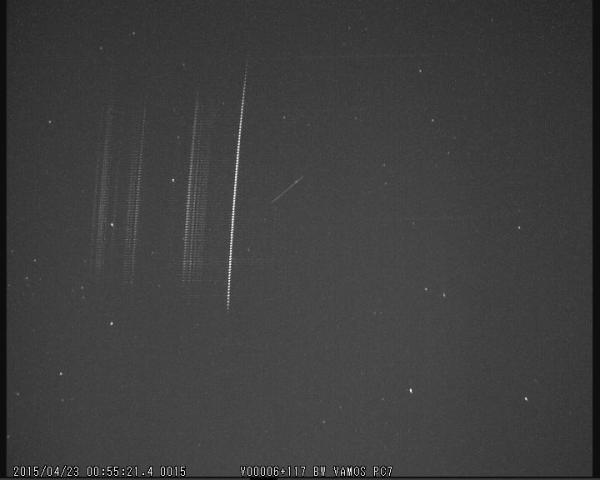
The instrument corrected graph.
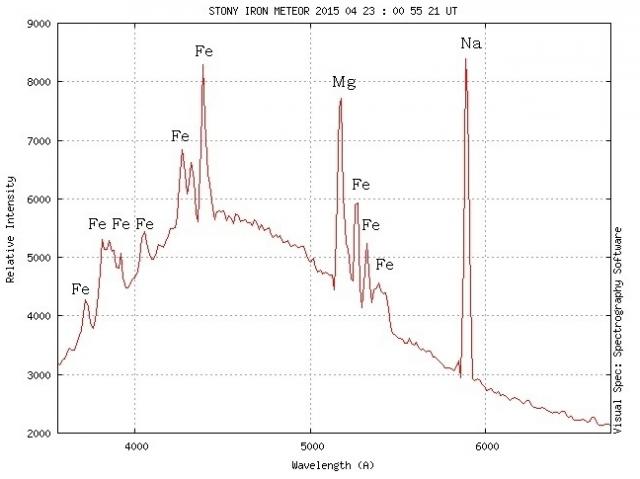
And of course the celestial art which just looks better….

cheers,
Bill.
15 August 2015 at 4:59 pm #576966 Bill WardParticipant
Bill WardParticipantHi,
Much to my surprise the night of the Perseid peak was clear all night. From22.00ut to 03.20ut I recorded 377 perseids and 51 others/sporadics. Out of these I captured 28 spectra, 8 of which were reasonably good.
One issue that has been problematic is correct “instrument correction” of the spectra. A flux corrected stellar spectrum can be used but what class of star to use? The temperatures that exist with the meteor head are high, several thousand kelvin but using a corresponding temperture of star/black body equivalent means that the shorter wavelength won’t be right. Similalry the reverse is true, correct for short wavelength then the long wavelengths go awry. This is especially a problem as silicon based detectors are hugely more sensitive in the red/near IR than the blue.
I thought it might be interesting to do a instrument correction by dividing through by a nominal silicon photodiode response.
I got a curve from a large photodiode manufacturer and normalised the curve at ~700nm, about halfway between the lowest responsivity and the peak at 820nm. The actual curve varies slightly depending on how the juntion is biased but this mostly affects the longer wavelengths which are being lowered by the division so the errors are small over all (I think 😉 )
Anyway here are a couple of graphs from a spectrum of a Perseid from this years peak. The difference is huge!, they don’t even look like the same spectrum the red has been lowered by that much. This actually shows how INsensitive silicon devices are to the far blue. (film was much better, who’d have thought….)
Uncorrected “raw” spectrum.
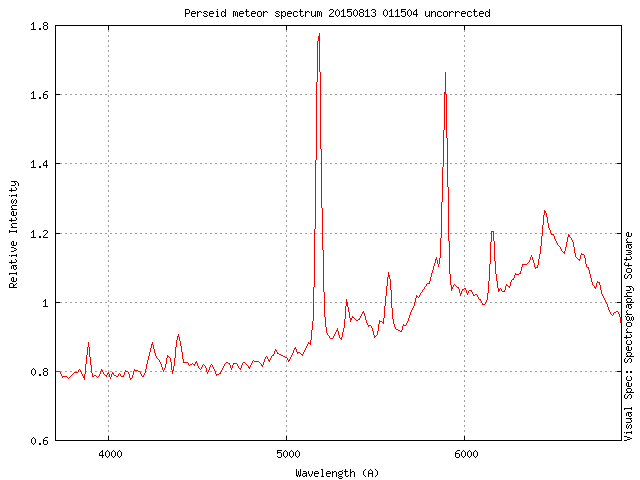
and the “corrected” spectrum
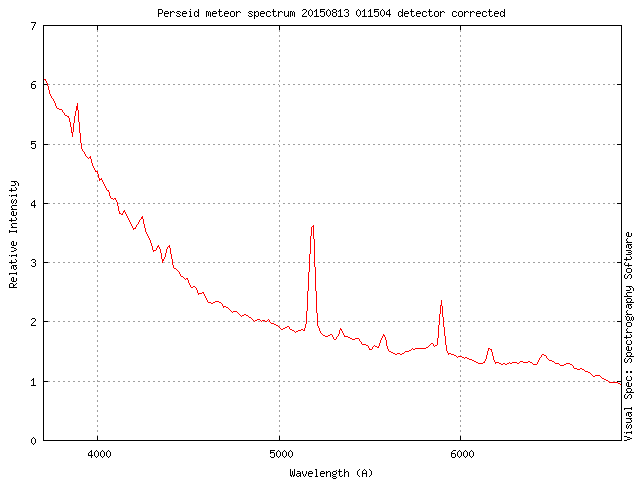
The red end may be a little over done as the original shows a rise in the graph caused by smoke wafting across the fov raising the backgroud level. However the blue end was reasonably dark and is fairly representative. This was the only spectrum of the night that had some blue lines to test the idea on. Its not a perferct example but demonstrates the point.
Having said all that acutal flux calibration is still subject to much uncertainty and is quite difficult to do in an easy manner for us amateurs.
Food for thought….
cheers,
Bill.
15 August 2015 at 5:57 pm #576967 Andy WilsonKeymaster
Andy WilsonKeymasterHi Bill,
I’m glad you had a successful night with the weather cooperating! That is a nice spectrum you have captured.
I’m not sure if there is any reason why you could not apply this to meteor spectroscopy, but when I am correcting for the instrument and atmospheric response I use an A type star. Ideally one with an easily available professionally corrected spectrum. The temperature of the star is not the important thing, it does not need to match the target. The instrument response will be calculated from my spectrum compared to the professional spectrum across all wavelengths. What matters is that A stars have very simple spectra so it is easy to smooth the response as there will just be a few blips for the hydrogen lines.
Best wishes,
Andy
16 August 2015 at 1:31 am #576968 Bill WardParticipant
Bill WardParticipantHi Andy,
Thanks for the comments. Using a A0 star was exactly what I did to start with. By removing the hydrogen lines this left a nice continuum. But what I found was that at the blue end it produced some odd results because of the shape of the continuum in this regime. In the basic library with Visual Spec the spectrum of Vega, for example has a sharp cut off then some oscillating components. Smoothing this out leads to dips in the continuum which I believe is not reflective of whats going on with a meteor. I could be plain wrong about this of course but I’ve made the assumption that even though a meteor may not have a genuine continuum the spectrum would be superimposed on a hypothetical blackbody continuum of the meteor temperture.
So it might very well be a two step process in the end. Divide through by the si response then do another division with the appropriate black body curve. The plan is to sort out this years Perseid results then go back and try some comparisons with normalised spectra from the ones I’ve collected using both the stellar method and si curve to see how they look.
However this issue isn’t of importance for basic line ID and wavelength calibrations but it’s a necessary step to get a good handle on it for proper flux calibration and measurement. The scientific papers I seen on this seem to me to be VERY complex and need complicated modelling of various parameters. So it’s possible to do but it might take someone with more computing and maths skills than me to crack!
Mmmm, tricky, very tricky but a fascinating challenge! 😉
cheers,
Bill.
16 August 2015 at 9:37 am #576969 Andy WilsonKeymaster
Andy WilsonKeymasterHi Bill,
That makes sense, in as much as something odd at the blue end in the reference spectra gives you trouble correcting the continuum. Do you know what the rough continuum shape should be for meteors? Any speculation on my part would more than likely be wrong.
I’m not sure if this will help, but sometimes I use BASS to process my spectra. This creates the response correction in a slightly different way. You still use your spectrum and a reference spectrum, but once you’ve done the division you use your mouse to select specific points on the divided spectrum. BASS then joins the dots to create a smooth response curve. I’m not sure if that would give you a way to create a response curve avoiding the dips or peaks.
Instrument and atmospheric correction is a tricky area. I’ve been struggling with it myself for the better part of this year, but I think I’m about there with my latest spectra.
Fascinating work you are doing. Like you say you can get lots of useful information even without the continuum correction.
Best wishes,
Andy
16 August 2015 at 1:15 pm #576970 Robin LeadbeaterParticipant
Robin LeadbeaterParticipantYes flux calibration of meteor spectra, even in relative terms is going to be tough. The instrument response can be corrected for using a reference star and provided atmospheric conditions are stable, even the atmospheric extinction con be accounted for by taking reference stars at different elevations and applying a correction based on the elevation of the meteor (The usual simpler technique of chosing a reference close in elevation to the target to cancel atmospheric extinction is problematic here of course !) A big problem though is likely to be flat field effects which can be severe with these sorts of wide field systems. A normal flat field correction does not work with slitless spectrographs. The usual workround is to place the reference star at the same position in the field thus cancelling gross flat field errors but again this is tricky here, particularly if the spectrum is generated by integrating along the track. Measurements of reference stars at the apropriate locations in the field the night after the meteor observations could perhaps be used though. Measuring standard star spectra with the star positioned at different points in the field and comparing them would give an idea of the severity of the flat field problem.
Cheers
Robin
16 August 2015 at 2:03 pm #576972 Robin LeadbeaterParticipant
Robin LeadbeaterParticipantBackground subtraction errors are also a common souce of instrument response problems in slitless spectroscopy and are worth looking out for. These tend to be most pronounced at the blue end where the instrument response drops off sharply so small zero errors have a large effect.
Robin
16 August 2015 at 2:38 pm #576973 Robin LeadbeaterParticipant
Robin LeadbeaterParticipantHi Bill,
You wrote..
> In the basic library with Visual Spec the spectrum of Vega, for example has a sharp cut off then some oscillating components.
There may be something wrong here. The 5A/pixel Pickles A0v spectrum in the Vspec library (file a0v.dat) shows a smooth decline in the continuum at the blue end as the Balmer lines merge towards the Balmer jump and a relatively flat continuum beyond that.
You can see it here for example where I use it to calculate the instrument response of my star analyser setup
http://www.threehillsobservatory.co.uk/astro/Spectroscopy_BAA_VSS_workshop_2008.pdf
in slide 38
Are you using a different spectrum at very high resolution perhaps ?
Note that correcting just using the CCD (or photdiode) response will not give a good result as the response of the grating (and the atmosphere) is also significant here
Robin
-
AuthorPosts
- You must be logged in to reply to this topic.
